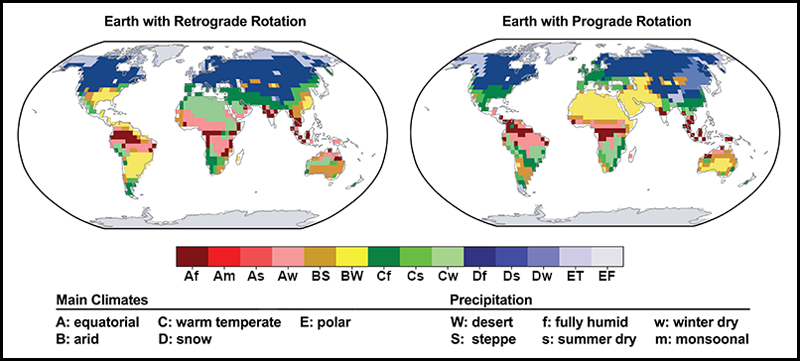A climate model with reversed rotation of Earth helps climatologists and oceanographers understand why our planet is the way it is and reveals how different it could have been.
By
Suppose some cosmic event, say, an asteroid impact, stopped Earth from rotating and then set it spinning the other way. What would the planet’s new climate be like?...
Suppose some cosmic event, say, an asteroid impact, stopped Earth from rotating and then set it spinning the other way. What would the planet’s new climate be like?...
The computer simulation revealed a backward spinning planet with a dramatically different distribution and abundance of desert lands, an otherworldly surge of cyanobacteria, and rerouted ocean currents, among other differences from our real, familiar planet. The findings were presented Monday at the annual General Assembly of the European Geosciences Union (EGU) in Vienna, Austria.

The Expected and the Unexpected
To create their version of a retro-Earth, Ziemen’s team stopped all movement of water and air. They then reversed the sense of the Coriolis force that tugs on all moving matter on a rotating planet, so that any cyclone would henceforth go clockwise on the Northern Hemisphere. They also reversed the daily path of the Sun, with New York 5 hours ahead of London.
The retrograde rotating Earth also included an unanticipated cyanobacterial surge. In the northern Indian Ocean, the interplay of circulation and high biological production caused low levels of oxygen at greater depths, making it necessary for microorganisms there to consume nitrate instead. The resulting water with low levels of nitrate made it possible for cyanobacteria, which don’t need nitrate, to become the dominant biological producers across a broad expanse of ocean where that nutrient-depleted water reached the surface. Whereas cyanobacterial blooms occur often on the actual Earth, they remain relatively small in scale, Ziemen said. “You can find cyanobacteria, and they may locally be important, but not in a large region.”...
A Backward but Kinder Earth?
Looking at the climate of the retrograde Earth, one might conclude that the study falsifies the conclusion of the German philosopher Gottfried Leibniz that for all that may be wrong with Earth, humankind lives in the “best of all possible worlds.” In some respects, the retrograde rotating Earth might seem to be the better place, with, for instance, 11 million square kilometers less desert than what is found on our actual planet...
—Bas den Hond (email: bas@stellarstories.com), Freelance Journalist
Citation: den Hond, B. (2018), Reversing Earth’s spin moves deserts, reshapes ocean currents, Eos, 99, https://doi.org/10.1029/2018EO096317. Published on 10 April 2018.
